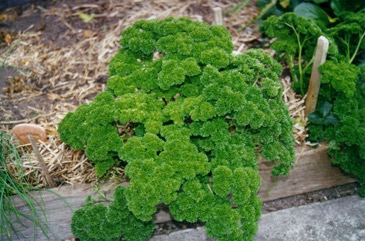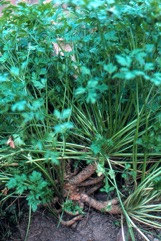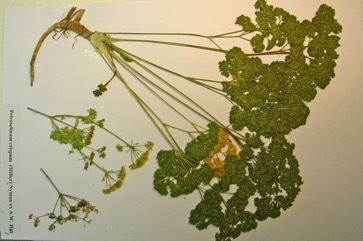Parsley

A temperate plant. It can be grown from sea level up to 2400 m altitude in the tropics. It grows best in moderately cool, shady and humid conditions. It can grow well in full sunlight but also in slight shade. Young plants can be damaged by frost. It is best with a pH of 5.0-6.0. It suits hardiness zones 7-9.
Also known as:
Achu mooda, Faan uen sai, Fan yan sui, Julivert, Maydanoz, Okhrakhushi, Patraseli, Peregil, Perejil, Persil, Petersilie, Pletik apu, Potrasoli, Pravi peteršilj, Prezzemolo, Salsa, Salsinha
Synonyms
- Apium crispum Mill.
- Apium petroselinum L.
- Petroselinum hortense Hoffm.
- Petroselinum sativum Hoffm.
- Petroselinum vulgare Lag.
- Crispum petroselinum
- and others
Edible Portion
- Leaves, Herb, Spice, Vegetable, Seeds
Where does Parsley grow?
Found in: Africa, Amazon, Argentina, Asia, Australia, Austria, Brazil, Britain, Cambodia, Canada, Caucasus, Central America, Central Asia, Chile, China, Cook Islands, Costa Rica, Cuba, Dominican Republic, East Africa, Europe, Fiji, Georgia, Greece, Guyana, Haiti, Hawaii, India, Indochina, Indonesia, Italy, Kazakhstan, Kenya, Kiribati, Kyrgyzstan, Laos, Lithuania, Macedonia, Malaysia, Mediterranean, Mexico, Mozambique, Myanmar, Nauru, New Zealand, Niger, North Africa, North America, Pacific, Pakistan, Papua New Guinea, PNG, Philippines, Portugal, Puerto Rico, Rotuma, Sao Tome and Principe, Saudi Arabia, SE Asia, Serbia, Slovenia, Solomon Islands, Somalia, South Africa, Southern Africa, South America, Spain, St Helena, Tajikistan, Tasmania, Thailand, Timor-Leste, Tunisia, Turkey, United States, Vanuatu, Vietnam, West Africa, West Indies, Zimbabwe
Notes: It is rich in iron, Vitamin A and Vitamin C.
Status: It is a commercially cultivated vegetable. It is one of the most popular herbs.
Growing Parsley
Cultivation: It is grown from seed and transplanted. Seeds are slow to germinate. They can be sown directly where they are to grow. Seed are collected by cutting flowers before they ripen then shaking the seeds out onto a cloth. Seed germinate in about 3-4 weeks. It is best to soak the seed in water for one day. Seedlings are transplanted and spaced at 45 cm.
Edible Uses: The leaves are used for flavouring. They are used in salads, sauces, stews, stuffings, and in other cooked dishes. The leaves can be dried or used fresh for tea. Parsley oil from the leaves or seeds is used in foods.
Production: Leaves are picked throughout the first growing season. The plant becomes bitter after flowering. The outer and larger leaves are harvested first.
Nutrition Info
per 100g edible portion| Edible Part | Energy (kcal) | Protein (g) | Iron (mg) | Vitamin A (ug) | Vitamin c (mg) | Zinc (mg) | % Water |
|---|---|---|---|---|---|---|---|
| Leaves - raw | 21 | 5.2 | 8 | 58 | 150 | 0.9 | 78.7 |
| Root | - | - | - | - | - | - | |
| Leaves - dried | 277 | 22.4 | 97.9 | 2334 | 122 | 4.8 | 9 |
Parsley Photos



References
Ambasta, S.P. (Ed.), 2000, The Useful Plants of India. CSIR India. p 442
Anderson, E. F., 1993, Plants and people of the Golden Triangle. Dioscorides Press. p 217
Arellanes, Y., et al, 2013, Influence of traditional markets on plant management in the Tehuacan Valley. Journal of Ethnobiology and Ethnomedicine 9:38 (As Petroselinum sativum)
Bernholt, H. et al, 2009, Plant species richness and diversity in urban and peri-urban gardens of Niamey, Niger. Agroforestry Systems 77:159-179
Bianchini, F., Corbetta, F., and Pistoia, M., 1975, Fruits of the Earth. Cassell. p 98
Bodkin, F., 1991, Encyclopedia Botanica. Cornstalk publishing, p 778
Bonet, M. A. & Valles, J., 2002, Use of non-crop food vascular plants in Montseny biosphere reserve (Catalonia, Iberian Peninsula). International Journal of Food Sciences and Nutrition (2002) 53, 225–248
Bremness, L., 1994, Herbs. Collins Eyewitness Handbooks. Harper Collins. p 264
Brickell, C. (Ed.), 1999, The Royal Horticultural Society A-Z Encyclopedia of Garden Plants. Convent Garden Books. p 776
Burkill, I.H., 1966, A Dictionary of the Economic Products of the Malay Peninsula. Ministry of Agriculture and Cooperatives, Kuala Lumpur, Malaysia. Vol 2 (I-Z) p 1729
Bussman, R. W., et al, 2016, A comparative ethnobotany of Khevsureti, Samtskhe-Javakheti, Tusheti, Svaneti, and Racha-Lechkhumi, Republic of Georgia (Sakartvelo), Caucasus. Journal of Ethnobiology and Ethnomedicine (2016) 12:4
Bussman, R. W. et al, 2017, Ethnobotany of Samtskhe-Javakheti, Sakartvelo (Republic of Georgia), Caucasus. Indian Journal of Traditional Knowledge Vol. 16(1) pp 7-24
Cheifetz, A., (ed), 1999, 500 popular vegetables, herbs, fruits and nuts for Australian Gardeners. Random House p 147
Cundall, P., (ed.), 2004, Gardening Australia: flora: the gardener's bible. ABC Books. p 1016
Curtis, W.M., 1963, The Students Flora of Tasmania Vol 2 p 256
Esperanca, M. J., 1988. Surviving in the wild. A glance at the wild plants and their uses. Vol. 2. p 132
Facciola, S., 1998, Cornucopia 2: a Source Book of Edible Plants. Kampong Publications, p 21
FAO, 1988, Traditional Food Plants, FAO Food and Nutrition Paper 42. FAO Rome p 399
Flora of Pakistan. www.eFloras.org
Foo, J.T.S.(ed), 1996, A Guide to Common Vegetables. Singapore Science Foundation. p 147
French, B.R., 2010, Food Plants of Solomon Islands. A Compendium. Food Plants International Inc. p 362
Hadfield, J., 2001, The A-Z of Vegetable Gardening in South Africa. Struik p 135
Hand-list of Herbaceous plants ed. 3, 122. 1925
Hedrick, U.P., 1919, (Ed.), Sturtevant's edible plants of the world. p 166
Hemphill, I, 2002, Spice Notes. Macmillan. p 285
Heywood, V.H., Brummitt, R.K., Culham, A., and Seberg, O. 2007, Flowering Plant Families of the World. Royal Botanical Gardens, Kew. p 35
Hibbert, M., 2002, The Aussie Plant Finder 2002, Florilegium. p 229
http://www.botanic-gardens-ljubljana.com/en/plants
Hussey, B.M.J., Keighery, G.J., Cousens, R.D., Dodd, J., Lloyd, S.G., 1997, Western Weeds. A guide to the weeds of Western Australia. Plant Protection Society of Western Australia. p 84
Hu, Shiu-ying, 2005, Food Plants of China. The Chinese University Press. p 603
Jardin, C., 1970, List of Foods Used In Africa, FAO Nutrition Information Document Series No 2.p 94
Kapelle, M., et al, 2000, Useful plants within a Campesino Community in a Costa Rican Montane Cloud Forest. Mountain Research and Development, 20(2): 162-171.
Katz, E., et al, 2012, No greens in the forest? Note on the limited consumption of greens in the Amazon. Acta Soc Bot Pol 81(4):283–293
Kayabasi, N. P., et al, 2018, Wild edible plants and their traditional use in the human nutrition in Manyas (Turkey). Indian Journal of Traditional Knowledge. Vol. 17(2), April 2018, pp 299-306
Kays, S. J., and Dias, J. C. S., 1995, Common Names of Commercially Cultivated Vegetables of the World in 15 languages. Economic Botany, Vol. 49, No. 2, pp. 115-152
Kiple, K.F. & Ornelas, K.C., (eds), 2000, The Cambridge World History of Food. CUP p 433, 1829
Kybal, J., 1980, Herbs and Spices, A Hamlyn Colour Guide, Hamlyn Sydney p 148
Ladio, A., Lozada, M. & M. Weigandt, 2007, Comparison of traditional wild plant knowledge between aboriginal communities inhabiting arid and forest environments in Patagonia, Argentina. Journal of Arid Environments 69 (2007) 695–715 (As Petroselinum sativum)
Lazarides, M. & Hince, B., 1993, Handbook of Economic Plants of Australia, CSIRO. p 186
Lentini, F. and Venza, F., 2007, Wild food plants of popular use in Sicily. J Ethnobiol Ethnomedicine. 3: 15 (As Petroselinum sativum)
Low, T., 1991, Wild Herbs of Australia and New Zealand. Angus & Robertson. p 67
Low, T., 1992, Bush Tucker. Australia’s Wild Food Harvest. Angus & Robertson. p 180
Mabey, R., 1973, Food for Free. A Guide to the edible wild plants of Britain, Collins. p 139
Martin, F.W. & Ruberte, R.M., 1979, Edible Leaves of the Tropics. Antillian College Press, Mayaguez, Puerto Rico. p 101, 222
Miguel, E., et al, 1989, A checklist of the cultivated plants of Cuba. Kulturpflanze 37. 1989, 211-357
Mulherin, J., 1994, Spices and natural flavourings. Tiger Books, London. p 98
Norrington, L., & Campbell, C., 2001, Tropical Food Gardens. Bloomings Books. p 70
Ochse, J. J. et al, 1931, Vegetables of the Dutch East Indies. Asher reprint. p 719 (As Petroselinum vulgare)
Omawale, 1973, Guyana's edible plants. Guyana University, Georgetown p 99
Oomen, H.A.P.C., & Grubben, G.J.H., 1978, Tropical Leaf Vegetables in Human Nutrition, Communication 69, Department of Agricultural research, RTI Amsterdam, p 95
Owen, S., 1993, Indonesian Food and Cookery, INDIRA reprints. p 83
Paczkowska, G. & Chapman, A.R., 2000, The Western Australian Flora. A Descriptive Catalogue. Western Australian Herbarium. p 148
Plants for a Future database, The Field, Penpol, Lostwithiel, Cornwall, PL22 0NG, UK. http://www.scs.leeds.ac.uk/pfaf/
Plants of Haiti Smithsonian Institute http://botany.si.edu
PROSEA
Purseglove, J.W., 1968, Tropical Crops Dicotyledons, Longmans. p 652
Ruiters-Welcome, A. K., 2019, Food plants of southern Africa. Ph.D. thesis. Univ. of Johannesburg p 20
Sharma, B.B., 2005, Growing fruits and vegetables. Publications Division. Ministry of Information and broadcasting. India. p 217
Smith, P.M., 1979, Parsley, in Simmonds, N.W., (ed), Crop Plant Evolution. Longmans. London. p 322
Terra, G.J.A., 1973, Tropical Vegetables. Communication 54e Royal Tropical Institute, Amsterdam, p 65
Tindall, H.D., 1983, Vegetables in the Tropics, Macmillan p 411
Tyagi, R. K., et al, 2004, Conservation of Spices Germplasm in India. Indian J. Plant Genet. Resour. 17(3): 163-174
van Wyk, B., 2005, Food Plants of the World. An illustrated guide. Timber press. p 287
Vickery, M.L. and Vickery, B., 1979, Plant Products of Tropical Africa, Macmillan. p 83
Walter, A. & Lebot, V., 2007, Gardens of Oceania. ACIAR Monograph No. 122. p 279
World Checklist of Useful Plant Species 2020. Royal Botanic Gardens, Kew